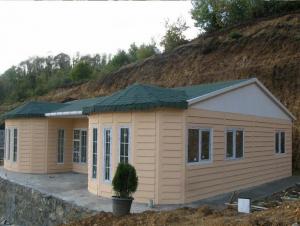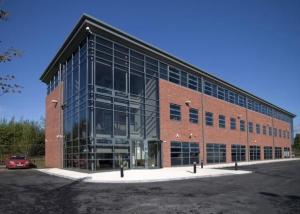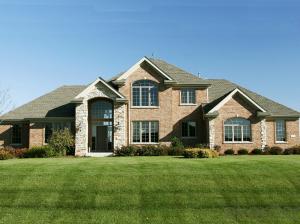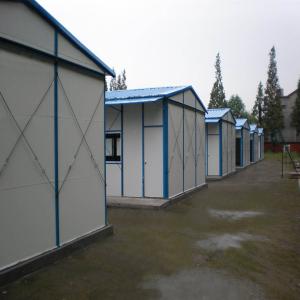Cheap mobile house
- Loading Port:
- China Main Port
- Payment Terms:
- TT OR LC
- Min Order Qty:
- -
- Supply Capability:
- -
OKorder Service Pledge
OKorder Financial Service
You Might Also Like
Specifications
Specifications prefabricated homes
1.Qualified material
2.Flexible design
3.Fast installation
prefabricated steel building Feature:
* Prefabrication, easy to install and disassemble
* Precision works, long life-span up to 15 years for use
* Lightness, easy to transport and relocate
* Using several times and recycling, economy and environment friendly
Prefab house Main material list as following:
Wall: 50mm/75mm thick EPS/Rockwool/PU sandwich panel
Roof: 50mm/75mm thick EPS/Rockwool/PU corrugated sandwich panel
Window: UPVC or Aluminum sliding window
Door: aluminum frame with panel same as wall panels(security door as optional)
Prefab house Joint material: steel column/aluminum alloy
1. Free from the damages by inspects, such as white ants and so on
2. Steel code: Q345, Q235
3. Designed life span: more than 30 years;
4. Green and environment-friendly materials used;
5. Seismic resistance up to 8 magnitudes
6. Safe---Able to stands for maximum 55 m/s typhoon
7. Advanced roof and wall cladding material guarantee excellent acoustic insulation, less 65% energy consumption than the concrete structure.
8. Additional 10%-15% net area compared to the traditional building, air cavity between the cladding and main structure guarantees the comfortable indoor space.
Prefab house advantage
1. Easy and quick to install;
2. Excellent load and span capabilities;
3. Significant savings in site installation costs;
4. Panel comes in a range of aesthetically pleasuring colors;
5. Energy saving thermal insulation;
6. Superior air tightness for controlled environments;
7. Good reactions to fire properties;
8. Durable, long lasting, stood the test of time in the extremes of harsh climate
- Q:Are container houses energy-efficient?
- Yes, container houses can be energy-efficient. They are designed to provide good insulation, reducing the need for heating and cooling. Additionally, container houses can incorporate energy-efficient systems such as solar panels, LED lighting, and energy-efficient appliances, further reducing energy consumption.
- Q:Are container houses suitable for religious or spiritual centers?
- Yes, container houses can be suitable for religious or spiritual centers. Container houses offer flexibility in design and can be customized to accommodate the specific needs of religious or spiritual practices. They are cost-effective, eco-friendly, and can be easily transported or relocated, making them ideal for setting up temporary or mobile centers. Additionally, container houses can be modified to create serene and peaceful environments conducive to meditation, prayer, or other religious activities.
- Q:What is a container house?
- A container house, also referred to as a shipping container home, is a housing structure crafted from repurposed shipping containers. These containers, typically constructed from steel, are designed to transport goods over long distances via ships, trains, and trucks. However, due to their strength, durability, and accessibility, they have gained popularity as an alternative building material for constructing homes. The construction of container houses involves stacking and combining multiple containers to create a larger living space. Depending on the desired outcome and design, containers can be modified and customized in various ways to cater to individual preferences. This includes cutting openings for windows and doors, adding insulation for temperature regulation, installing plumbing and electrical systems, and incorporating interior finishes to establish a comfortable living environment. Container houses bring numerous benefits. Primarily, they are an environmentally friendly housing option as they repurpose existing resources. By utilizing shipping containers, we reduce waste and prevent them from being discarded in landfills. Furthermore, container houses are cost-effective compared to traditional construction methods. The utilization of pre-existing containers significantly reduces the expenses associated with materials and labor, making them an affordable housing solution for many. Additionally, container houses are exceptionally durable and resistant to weather conditions due to their original purpose of enduring harsh transportation conditions. These structures are built to withstand extreme weather events such as hurricanes and earthquakes, and are designed to have a lifespan of several decades. Container houses also offer flexibility and versatility. They can be transported to different locations, providing the potential for mobile or temporary housing solutions. Moreover, container houses can be easily expanded or modified, allowing for future growth or adjustments to living requirements. In summary, a container house is an innovative and sustainable housing option that combines functionality, affordability, and versatility. It offers a distinctive and contemporary living space while simultaneously contributing to waste reduction and minimizing environmental impact.
- Q:Can container houses be designed to blend in with the surrounding environment?
- Yes, container houses can be designed to blend in with the surrounding environment. Architects and designers can incorporate various strategies to achieve this, such as using natural or earthy colors for the exterior, incorporating green roofs or living walls, and integrating the structure into the landscape through thoughtful placement and landscaping. Additionally, materials like wood cladding or stone veneer can be used to soften the industrial appearance of the containers and help them harmonize with their natural surroundings.
- Q:Are container houses suitable for educational facilities?
- Yes, container houses can be suitable for educational facilities. They offer several advantages such as cost-effectiveness, quick construction time, and flexibility in design. Container houses can be customized to create classrooms, libraries, or administrative spaces. Additionally, they are portable and can be easily relocated if needed. However, proper insulation, ventilation, and structural modifications must be ensured to meet the specific requirements of educational facilities.
- Q:Ordinary residential, bungalow, apartment What is the definition of each, what is the difference?
- Bungalows: ? architectural style for foreign style, Western flavor full, mostly European and North American style, there are a little Nanyang style;
- Q:What are the benefits of warehouse outsourcing?
- effectively reduce the warehouse waste rate, the general warehouse outsourcing, leasing area than their management of the warehouse to reduce 1/3 or so.
- Q:Can container houses be designed with solar power systems?
- Yes, container houses can definitely be designed with solar power systems. The modular nature of container houses allows for easy integration of solar panels on the roof or sides of the structure. This renewable energy source can effectively power the electrical needs of the house, making it a sustainable and eco-friendly housing option.
- Q:How much does a container house cost?
- The cost of a container house can vary depending on various factors such as size, location, design, materials used, and additional features. On average, a basic container house can range from $20,000 to $50,000. However, more elaborate and customized container houses with high-end finishes and amenities can cost upwards of $100,000 to $200,000. It's important to note that these figures are approximate and can differ significantly based on individual preferences and specifications. Additionally, costs may also include expenses related to land acquisition, permits, foundation, utilities, and interior furnishing.
- Q:Can container houses be insulated for soundproofing?
- Container houses have the potential to be soundproofed, despite their steel composition that allows for easy sound transmission. Multiple techniques can be employed to insulate them and minimize noise transfer. One popular method involves utilizing insulation materials like mineral wool or foam to fill the walls, ceilings, and floors of the container. This effectively absorbs and reduces sound vibrations, preventing their propagation through the walls. Moreover, incorporating acoustic panels or soundproof curtains within the interior can enhance sound insulation even further. To guarantee a successful and efficient insulation solution for container houses, it is essential to collaborate with experienced professionals in the field of soundproofing.
1. Manufacturer Overview |
|
|---|---|
| Location | |
| Year Established | |
| Annual Output Value | |
| Main Markets | |
| Company Certifications | |
2. Manufacturer Certificates |
|
|---|---|
| a) Certification Name | |
| Range | |
| Reference | |
| Validity Period | |
3. Manufacturer Capability |
|
|---|---|
| a)Trade Capacity | |
| Nearest Port | |
| Export Percentage | |
| No.of Employees in Trade Department | |
| Language Spoken: | |
| b)Factory Information | |
| Factory Size: | |
| No. of Production Lines | |
| Contract Manufacturing | |
| Product Price Range | |
Send your message to us
Cheap mobile house
- Loading Port:
- China Main Port
- Payment Terms:
- TT OR LC
- Min Order Qty:
- -
- Supply Capability:
- -
OKorder Service Pledge
OKorder Financial Service
Similar products
New products
Hot products





























